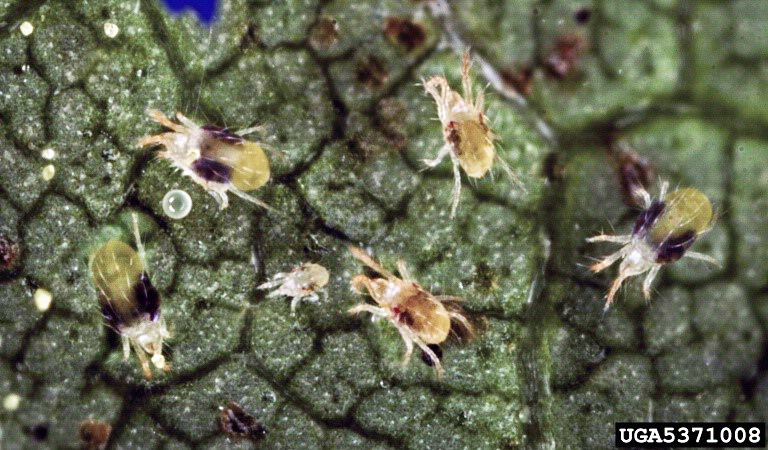Two-spotted spider mite. Adults, nymph, and egg.(Photo/ David Cappaert, Bugwood.org)Talking Plants
University of Minnesota, Clay County
Spider mites are a common pest of houseplants. They prefer warm, dry environments with low humidity levels. Feeding damage results in chlorotic spots or a stippled appearance on plant leaves. Webbing may also be present. Luckily, they are rather easy to control.
The most common spider mite found on houseplants is the two-spotted spider mite. The adult has eight legs with an oval shaped body and is approximately 1/50 of an inch long. The body is commonly greenish or almost translucent although it may be brown to orange-red. It has two dark spots on its body that are easily viewed using a 10X to 15X magnifying lens. Spider mites are not insects. They are a type of arachnid and closely related to spiders and ticks.
If your houseplants are infested with spider mites, consider moving them to a cooler room away from healthy plants. Keep the soil moist but not overly saturated. A good rule of thumb is to water your houseplants when the top half inch of soil is dry. Washing plant foliage using a soft cloth or a forceful spray of lukewarm water can help reduce the spider mite population if done repeatedly. Other control options include treating plants with an insecticide containing permethrin or pyrethrin. Insecticidal soap and horticultural oil are also effective. If using a pesticide, always read the label carefully before buying and again before using the product. This is especially important as the availability and recommended use of specific pesticides may change from year to year. The label is the final authority on how you may legally use any pesticide.
If the infestation is severe with most of the plant being covered with spider mites the best control option is to discard the plant. Before removing, place a plastic bag over the plant to help prevent any spider mites from migrating to other houseplants. To prevent future infestations, keep newly acquired houseplants in an isolated area, away from other houseplants for a few weeks. Use this time to monitor the plants for any pest problems before placing them with the rest of your healthy plants.
University of Minnesota,Clay County 218.299.5020.
Check out our website at https://local.extension. umn.edu/local/clay


